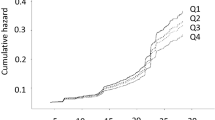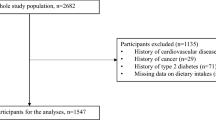Abstract
Westernization of lifestyles among Japanese, in particular among young generations, is a matter of concern for future increase in coronary heart disease. We surveyed a total of 349 male university students to examine changes in lifestyles and coronary risk factors in campus life. We compared dietary habits and serum fatty acid compositions as well as other coronary risk characteristics between freshmen (n=171) and fourth-year (senior) students (n=178). Serum fatty acid compositions and dietary intakes of selected foods as well as serum lipids, blood pressures and physical characteristics were examined at the 1996 and 1997 annual health examinations.
Compared to freshmen, senior students had a lower frequency of fish, vegetable, milk and egg intake, and a higher frequency of oil and fat intake. The proportions of serum saturated and monounsaturated fatty acids were significantly higher among senior students than among freshmen, whereas the proportion of serum polyunsaturated fatty acids was significantly lower among senior students than among freshmen. Senior students also had higher systolic and diastolic blood pressures, percent body fat, smoking rate and alcohol usage than freshmen. Mean body weight and mean body mass index were not different between the two groups.
Senior students generally showed Westernized dietary habits and higher coronary risk profiles than freshmen as indicated by the change of serum fatty acid compositions. Modification of these dietary habits and lifestyles may be important for the prevention of future CHD among Japanese young adults.
Similar content being viewed by others
References
Keys A. The diet: Coronary heart disease in seven countries. Circulation 1970; 42 (Suppl 1): 162–183.
Organization for Economic Co-operation and Development. Food consumption statistics 1964–78. Paris: OECD, 1981.
Yamori Y, Nara Y, Iritani N, Workman RJ, Inagami T. Comparison of serum phospholipid fatty acids among fishing and farming Japanese populations and American inlanders. J. Nutr. Sci. Vitaminol. 1985; 31: 417–422.
Iso H, Sato S, Folsom AR, Shimamoto T, Terao A, Munger RG, Kitamura A, Konishi M, Iida M, Komachi Y. Serum fatty acids and fish intake in rural Japanese, urban Japanese, Japanese American and Caucasian American men. Int. J. Epidemiol. 1989; 18: 374–381.
Benfante R. Studies of cardiovascular disease and cause-specific mortality trends in Japanese-American men living in Hawaii and risk factor comparisons with other Japanese populations in the Pacific region: a review. Hum. Biol. 1992; 64: 791–805.
Summary of the National Surveillance Report of Nutrition Status in 1998, Ministry of Health and Welfare. Elyogaku Zasshi 1998; 56: 359–370. (in Japanese)
Tamura Y, Horiyasu T, Kobayashi T, Nishimura K, Wakisaka K, Komuro R, Umemura U. Dietary habits in the young university students.—Comparison between male and female students— Proceeding of the 34th conference on Health Science and Administration. 1996; 34: 148–152 (in Japanese)
Kobayashi T, Tian Y, Nishimura K, Wakisaka K, Komuro R, Tamura Y, Sano Y, Horiyasu T, Umemura U, Ishimori M, Watanabe S, Iso H, Shimamoto T, Lida M. Study on the relationship between dietary habits and serum lipids/fatty acids in young male university students. Campus Health 1999; 35: 107–114. (in Japanese)
Nunez C, Beyer J, Strain G, Zumoff B, Kovera A, Gallagher D, Heymsfield SB. Composition of weight loss while dieting: Comparison of research and clinically-based methods. Proceeding of North American Association for the Study of Obesity (NAASO) 1999.
Nakamura M, Morita M, Yabuuchi E, Yukami M, Kuruma S et al. The evaluation and the results of cooperative choresterol and triglyceride standardization program by WHO-CDC. Rinsho Byori 1982; 30: 325–332. (in Japanese)
Murata M. Sceiologic background of increased cardiovascular risk factors in childhood. Shoni Naika 1992; 24: 1315–1320. (in Japanese)
Umemura U, Iso H, Koike KA, Kudo M, Shimamoto T, Ito K, Kanbayashi M, Sugiyama S, Sato S, Lida M, Komachi Y. Dietary habits and serum fatty acid compositions of women college students—changes in serum lipids and fatty acids by dietary education. Nippon Koshu Eisei Zasshi 1993; 40: 1139–1154 (in Japanese)
Surveillance report in health status of university students: Basic information. Report from Council of Health Administration Centers. 1995. (in Japanese)
Surveillance report in health status of university students: Advanced Information. Report from Council of Health Administration Centers. 1995. (in Japanese)
Dyerberg J, Bang HO. Haemostatic function and platelet polyunsaturated fatty acids in Eskimos. Lancet 1979; 2: 433–435.
Dyerberg J, Bang HO, Hjorne N. Fatty acid composition of the plasma lipids in Greenland Eskimos. Am. J. Clin. Nutr. 1975; 28: 958–966.
Kromhout D, Bosschieter EB, de Lezenne Coulander C. The inverse relation between fish consumption and 20-year mortality from coronary heart disease. N. Engl. J. Med. 1985; 312: 1205–1209.
Daviglus ML, Stamler J, Orencia AJ, Dyer AR, Liu K, Greenland P, Walsh MK, Morris D, Shekelle RB. Fish consumption and the 30-year risk of fatal myocardial infarction. N. Engl. J. Med. 1997; 336: 1046–1053.
Sato S. Epidemiological study on new risk factors for cardiovascular disease: serum fatty acid and plasma fibrinogen. J. Epidemiol. 1998; 8 (Suppl): 70.
Ascherio A, Rimm EB, Stampfer MJ, Giovannucci EL, Willett WC. Dietary intake of marine n-3 fatty acids, fish intake and the risk of coronary disease among men. N. Engl. J. Med. 1995; 332: 977–982.
Archer SL, Green D, Chamberlain M, Dyer AR, Liu K. Association of dietary fish and n-3 fatty acid intake with hemostatic factors in the coronary artery risk development in young adults (CARDIA) study. Arterioscler. Thromb. Vasc. Biol. 1998; 18: 1119–1123.
Blankenhorn DH, Johnson RL, Mack WJ el Zein HA, Vailas LI. The influence of diet on the appearance of new lesions in human coronary arteries. JAMA 1990; 263: 1646–1652.
Wood DA, Butler S, Riemersma RA Thomson M, Oliver MF, Fulton M, Birtwhistle A, Elton R. Adipose tissue and platelet fatty acids and coronary heart disease in Scottish men. Lancet 1984; 2: 117–121.
Wood DA, Riemersma RA, Butler S, Thomson M, Macintyre C, Elton RA, Oliver MF. Linoleic and eicosapentaenoic acids in adipose tissue and platelets and risk of coronary heart disease. Lancet 1987; 1: 177–183.
The Expert Panel. Report of the National Cholesterol Education Program Expert Panel on Detection, Evaluation, and Treatment of High Blood Cholesterol in Adults. Arch. Intern. Med. 1988; 148 36–69.
Umemura U, Koike K, Iso H, Sankai T, Shimamoto T, Sato S, Iida M, Handa K, Komachi Y. Population-based comparative study on dietary habits and serum fatty acid compositions. Nippon Eiseigaku Zasshi. 1993; 48: 939–954. (in Japanese)
Umemura U, Yokota K, Inagawa M, Iso H, Sankai T, Imano H, Shimamoto T, Koike K, Lida M, Komachi Y. Effectiveness of a health education class to increase fish intake evaluated by serum fatty acid compositions. Nippon Koshu Eisei Zasshi. 1997; 44: 901–909. (in Japanese)
Umemura U, Ishimori M, Watanabe S, Iso H, Shimamoto T, Koike K, Kobayashi T, Iida M. Effects of intake of fish rich in n-3 polyunsaturated fatty acid on serum lipids, serum fatty acid component and hemostatic factors. Nippon Eiyo-Shokuryo gakkaishi. 2000; 53: 1–9 (in Japanese)
Author information
Authors and Affiliations
Corresponding author
Rights and permissions
About this article
Cite this article
Kobayashi, T., Umemura, U., Iso, H. et al. Differences in dietary habits, serum fatty acid compositions and other coronary risk characteristics between freshmen and fourth-year male university students. Environ Health Prev Med 6, 143–148 (2001). https://doi.org/10.1007/BF02897961
Received:
Accepted:
Issue Date:
DOI: https://doi.org/10.1007/BF02897961




